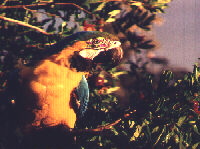 |
| Home |
| Who We Are |
| Save The Parrots |
| Books |
| Links |
| Volunteers |
| Articles |
| Avian Vet Listing |
| Email Us |
First Published in Birdworld magazine July/August 1989
Box 13, Point Arena, CA 95468 USA
PH: (213) 819-1723
macaws@parrotpro.com
 An interest in breeding larger birds, or just having one to love, often begins with the ownership
of the still fairly inexpensive, elegant, Blue and Gold Macaw. We purchased our first male in l982, a one-year old former pet. He was sadly in need of a better diet and better
care. He had already been through at least 3 hands when he arrived at our farm. In l984, we purchased two females from quarantine;( we had two males by then,) and re-quarantined
the females for 30 days.
An interest in breeding larger birds, or just having one to love, often begins with the ownership
of the still fairly inexpensive, elegant, Blue and Gold Macaw. We purchased our first male in l982, a one-year old former pet. He was sadly in need of a better diet and better
care. He had already been through at least 3 hands when he arrived at our farm. In l984, we purchased two females from quarantine;( we had two males by then,) and re-quarantined
the females for 30 days.
A month after introducing the pairs, the females became ill and both died. Because of this, I cannot emphasize enough the importance of weighing your birds from time to time. This can help you detect changes and potential illness' before they get out of hand. (This was in the heyday of birds arriving in mass shipments from out of the country, and stress played an important factor in their demise). The gentleman who owned the shipment of birds, perhaps 1500 of them, very kindly gave us another bird, assumed to be a young hen. She was scruffy-looking, not a tail or a wing feather on her, and would have been my last choice if I had a choice. Looks are deceiving!! She is now one of my finest breeding females. The pair have produced some 38 babies to date!
There is much to be said for purchasing domestic-bred stock to use for breeding. Now that there are more babies available, I try to purchase only domestic birds. The medications and stresses that quarantined birds have been subjected to can delay breeding by several years. At this point, I have a blend of ex-pets, quarantined birds, and domestic babies. I keep some of my own babies to trade with other breeders for birds that will be put back into breeding stock. An imported bird can be put into good condition, given ample time, and an ex-pet can be rehabilitated, given even more time. Generally the wait is shorter if you start with domestic babies.
This hen and her mate are housed in a chain-link cage, 8'x8'x15', which is covered with sheet metal on one end and 1/3 of the way along the sides and roof. Mature citrus trees are planted on either side. The adjoining cage is about 8' away on the other side of the tree. Pairs can socialize because they can see each other but still have privacy. The nest barrel, a 55 gallon steel drum, is hung up in the secluded section, sideways, and has a small peek hole accessible only by entering the aviary. Sometimes this is difficult. The entrance to the nest is a 10 inch hole, centered about 2/3 of the way up the midsection of the drum. Nest materials are primarily straw, some eucalyptus leaves. I do not use cedar chips or redwood chips or wood shavings--some are toxic, and others just injestable with fatal results for tiny babies. Some cages have half-sheets of plywood for privacy screens, but over the years these just get destroyed, and as the trees have matured the need for extra shelter from the wind has been eliminated. Perches are natural branches, eucalyptus, mulberry, citrus and local desert woods. There is a misting system for hot days, and these birds stay outdoors year around.
Our adult birds are fed fresh greens, fruits, and vegetables in the mornings. In the evening they get safflower and sunflower seed, dog chow, or peanuts and bread. Cod liver oil and vitamins are sprinkled on the sticky foods, as well as powdered lactobacillus supplements. I use some powdered calcium supplements in breeding season, just to make sure that the hens are not depleting their own bodies as they lay eggs. Feeding and checking is done twice each day. In the evening they are fed just what will be consumed in 15 minutes, to avoid feeding the crowd of local birds. When you have the only feeding station for miles of pristine desert, everyone comes in for a meal!
It was three years later , in l986, that one pair started to exhibit breeding behavior. The male became possessive of her, and quite aggressive toward me. They laid two clutches of eggs, 5 total, and all the eggs were clear. It seems that many "first time pairs" produce clear eggs - some birds are too fat, most are just inexperienced. I have purchased pairs from people who were frustrated with clear eggs for several clutches, and have them producing for me now.
In l987 there were again two clutches, with a total of 6 eggs. Of these, 5 hatched. The first clutch was in May, and the second in July. In l988 we decided to remove all the eggs for a season, just to see what a now-producing macaw would do, and we got 11 eggs; three in April, three in May, three in July and two in August. This kept us very busy. As you will see by the baby charts, the initial weight differences between parent-reared youngsters and people-reared youngsters is tremendous.
Babies, no matter when they are removed for hand-feeding, are treated like the individuals that they are. Whenever they are wakeful or fussy, they are fed. They are kept at proper temperatures, proper humidity, proper light levels, and proper schedules. The parents keep them stuffed all the time. Keep them warm enough; feel their wingtips and toes to judge temperature. A too hot baby will pant and be red-skinned, a too cold baby will not digest its food properly and may even shiver. Weigh them daily and keep a record. Over a period of time this will be an important indicator of how you are doing as a surrogate parent, as well as give you an early warning if baby is not doing well.
We use transfer pipettes for the little ones and change to a bent spoon when their mouths are big enough to use a spoon. We do not recommend shoving anything down the babies' throats. Tube feeding for babies would only be for very sick babies. You can easily kill one if the tube goes into the lungs--and there is no undoing that.
We make our own formula, a dry mix which is easily stored. Meat, fruit and vegetables are added, well mashed, as well as cod-liver oil. Be careful not to add too many filler-type vegetables, like carrots. I had a weight gain problem when too many carrots were being fed. Weight charts showed us quite quickly where the problem was. Just add hot tap or bottled water to this formula (listed at the end of this article) and let it sit a minute while the mix thickens. Clean the beaks inside and out after each feeding. I do not use a microwave oven as this can create hot spots in a formula, and can result in a crop burn. The primary rules for baby keeping are Clean, Warm, Dry and Full.
From this one pair, babies have been raised three different ways. Incubated babies are the most work as tending eggs is a constant process of hand monitoring and turning. The first few days of feeding is "every 45 minutes around the clock". Babies pulled from the nest at three days or so tend to be fed every two hours. This is still a lot of work, as around the clock means all night too.
Parent reared babies are be far the easiest to work with. We removed this clutch at 16 days. Their eyes start to open on the 19th day, and it is important that they bond to people if they are to become handleable.
There are still no hard and fast rules in birdbreeding; one baby , the fourth, hatched some 10 days after the third baby; a good reason to leave a "dud" egg alone for a few days.
When the parents are doing the work of feeding, I feed them every two hours from dawn to dark. This is particularly important if there is more than one baby. What the big birds are fed pretty much goes straight into the baby, so make sure it is fresh.
Check the babies every day. I use a flashlight and a mirror and a piece of old freezer case wire shelving. The wire is to place over the nest entrance so the parents dont bite me. Shine the light into the hole and use the mirror (the nest is up over my head) to check every corner. Make sure the crops are full on all infants and that they are being kept together in a group. If there is a smaller baby, make sure he is not being pushed down by the older babies. You may have to pull some or all of the babies to prevent the death of one.
Sometimes you can use a mirror that is large enough to cover the entire entry hole. This way the parents see what they think is another bird and not see you. This equals less stress for them.
Babies are closed banded at approximately 10 ounces in weight. Generally they will start eating formula by themselves at the 100th day. Slimming begins just prior to attempted flights and weaning. Weight gains start again at about the 19th week. Overall losses during weaning average 2 to 3 ounces; more than that is cause to see your veterinarian. Again, keep those weight charts!
4 cups Gerber High Protein Baby Cereal
4 cups Kretchmers Wheat Germ Cereal
2 cups powdered milk
4 cups Quaker white corn masa mix
6 T Blairs
Super Preen Bird Vitamins or equalivalent
4 T Di Calcuim Phosphate supplement
2 T Lactobacillus Acidophilus bacteria (sold under the trade name Ornabac at better feed stores)
Mix all this dry stuff together and set aside.
*TO MAKE THE IMPROVED FORMULA: Follow this exactly.
- Boil 2 cups of distilled water.
- Add this to 1/2 cup of Soy Flour in a large bowl and mix well until lumps are mostly gone.
- Add 3/4 cup of peanut butter to this, and allow it to cool for about 3 minutes.
- Then add a cup of the mix (as above) and some cool distilled water.I allow it to cool a bit so the vitamins are not 'cooked out'. If you choose to refrigerate this, leave it a bit thick, and add hot water to mix to feeding consistency. If you choose to use it all immediately, make sure it is not too hot, thick, or thin.
- If you accidentally mix it a bit thin when you are reconstituting it, just add a little of the dry mix to thicken it.
- Special note about soy flour; this is included in lots of commercial formulas, but the trick here is to COOK it in the hot water so it is digestible, but not to cook it on the stovetop. I find that cooking it in a bowl is just right.